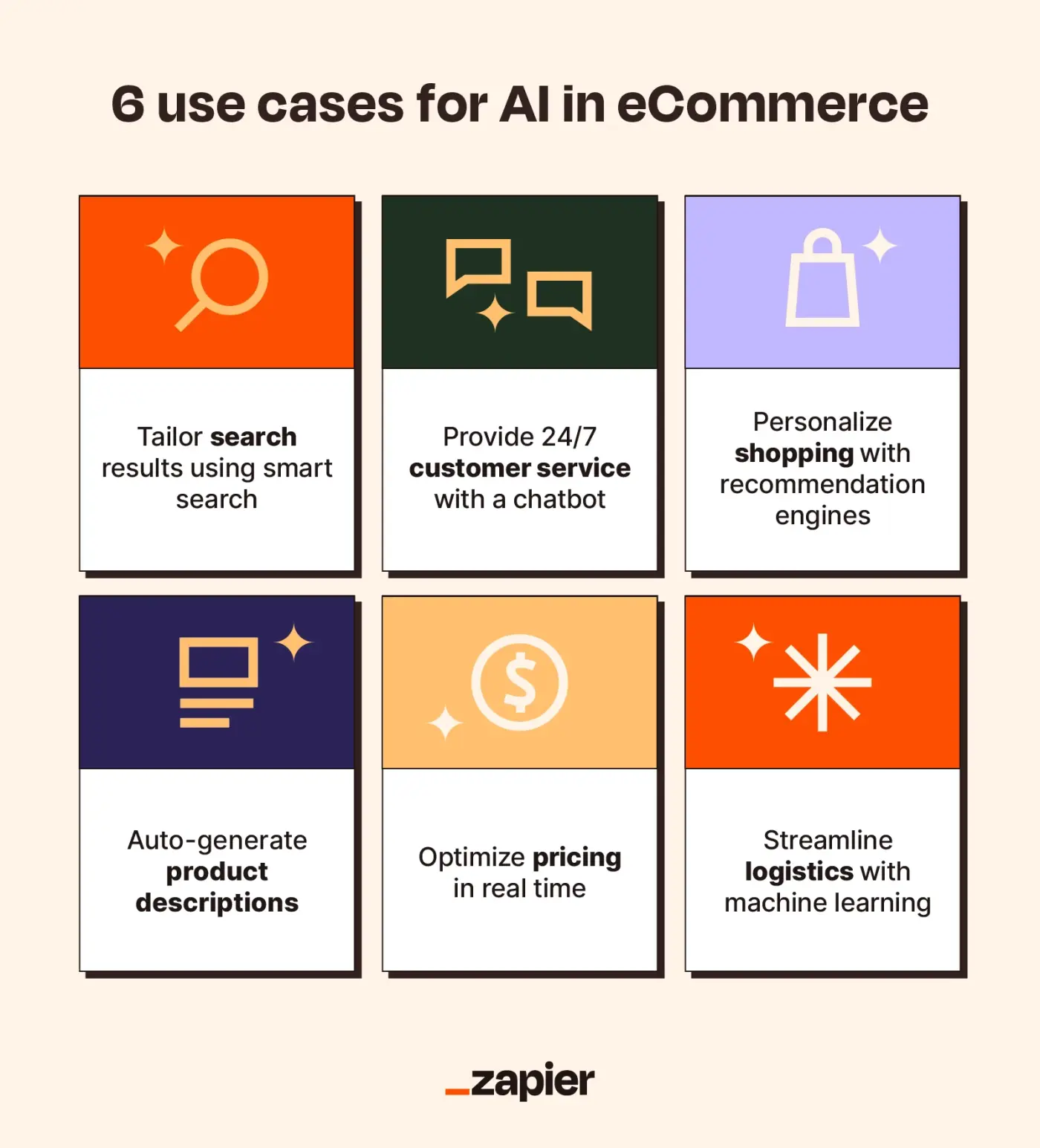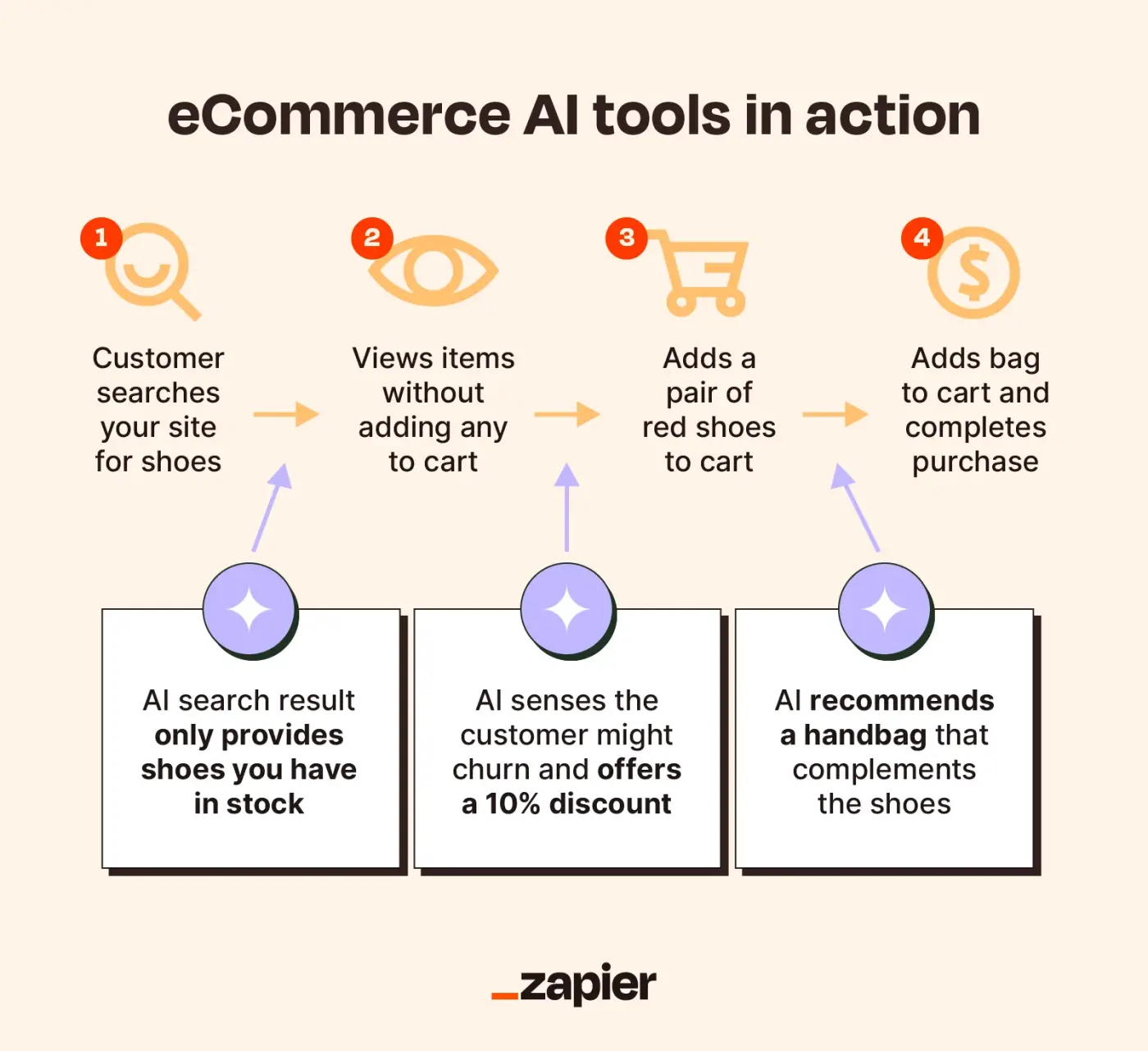We’ve all experienced it at some point. You spend an hour scrolling through workout clothes online, picturing yourself conquering that marathon (or at least looking good trying). But then you get hit with that dreaded analysis paralysis, putting off the purchase and your marathon dreams until next year…again.
If you’re not using AI for your eCommerce business, chances are your customers have experienced something similar on your site. And product recommendations are only the first step in a long race: AI can help you with everything from pricing and logistics to customer service and personalized search. Here’s how to make the most of it.
Table of contents:
How AI is used in eCommerce
AI is a broad term, I know. Here’s a brief breakdown of some foundational AI technologies and how they’re applied in eCommerce:
-
Machine learning (ML) allows AI systems to learn and improve without explicit programming. ML algorithms identify patterns and make predictions by analyzing data. In eCommerce, this is used for tasks like product recommendations and fraud detection.
-
Natural language processing (NLP) enables AI to understand and respond to human language (making chatbots and smart search functions possible). NLP can analyze user queries, translate languages, and even generate human-quality text.
-
Computer vision lets AI interpret and understand visual information. In eCommerce, it powers things like visual search, where users can find products by uploading images.
-
Deep learning is the next step in machine learning. Deep learning models are particularly adept at handling complex tasks like image and speech recognition, making them valuable for things like product recommendations and visual search.
-
Augmented reality (AR) and virtual reality (VR) allow customers to virtually try on products, creating immersive shopping experiences in virtual storefronts.
-
Predictive analytics enables AI models to anticipate future product demand to optimize inventory and forecast sales trends.
6 examples of AI in eCommerce
From personalizing product recommendations (like those $200 running shoes you can’t run a theoretical marathon without) to optimizing your inventory, AI is making it easier to buy and sell online. These examples are meant to help you brainstorm your own use cases for implementing AI in your eCommerce business.

1. Shopify: Semantic search
Traditional search tools can usually get the job done when the shopper knows exactly what they’re looking for. But most of us know the frustration of trying to find a thingamajig when words fail us. It’s a losing battle.
AI is making search tools smarter. Smart search uses AI to understand the intent behind the customer’s search, not just the exact words. For example, Shopify offers merchants what it calls “Semantic Search,” which considers factors like synonyms, related concepts, and even the image data of your products. So, if a customer types in “workout clothes for summer,” semantic search goes beyond simply matching products with “workout clothes” or “summer.”
It recognizes the user’s intent to find clothes suitable for physical activity during warm weather. The search then surfaces items like breathable tank tops, moisture-wicking leggings, and shorts, even though those keywords weren’t used in the search. This improves the relevance of search results and helps customers find what they’re looking for without making multiple queries.
2. Photobox: AI chatbots
Adding AI into customer service operations provides tirelessly helpful support around the clock. Unlike human representatives with set working hours, AI chatbots are available 24/7 to answer customer questions, guide them through product searches, and even troubleshoot issues. Some eCommerce tools come with built-in AI chatbots, or you can quickly build your own AI chatbot for free with Zapier. This allows you to create bots that match your brand and perform unique actions.
Printing business Photobox uses AI chatbots to provide 24/7 customer support as well as extra assistance during seasonal surges when it’s all but impossible to train new agents. These bots can interact with customers in multiple languages, find orders, and give instructions for basic tasks.

3. Best Buy: A recommendation engine
Recommendation engines are like the sidekick to AI-powered search engines. While a search engine shows you what you’re looking for, a recommendation engine suggests products you might also be interested in by using a combination of machine learning and data analysis.
This can be based on a user’s past purchases, browsing history, or even similar customers’ buying habits. For instance, Best Buy’s recommendation engine might analyze your past purchases of a new laptop and suggest complementary items like a wireless mouse or keyboard based on what other customers with similar purchases have chosen.

4. Amazon: Generative AI
We all have time-consuming tasks we’d like to pawn off on somebody else, but small businesses can rarely afford the luxury. Generative AI in eCommerce provides a cost-effective way to accomplish tedious duties you may not want to do or be skilled at, like writing engaging product descriptions.
Amazon, for instance, has a generative AI tool that analyzes product data like the title, specifications, and reviews to help you find the most relevant talking points. It then instantly generates descriptions that play up those aspects. This can save sellers a ton of time and ensures their product descriptions are optimized for search engines, boosting product visibility and driving sales.
5. Intuz: Real-time dynamic pricing
A well-timed discount can be the difference between a sale and a missed opportunity. If you’re running an eCommerce business, you don’t have the chance to read your customer and drop the price to make a sale like a car salesperson might. Using eCommerce AI can help you get that competitive edge back with dynamic pricing.
Companies like Intuz offer AI-powered solutions that analyze a treasure trove of data, including market trends, competitor pricing, and customer demographics. Intuz then uses this data to suggest optimal pricing strategies. For example, during peak demand periods, Intuz might suggest raising prices slightly. Conversely, during slower periods, the AI might recommend lowering prices to stimulate sales and move inventory. It can even automatically adjust prices according to pre-defined rules.

6. Sally Beauty Holdings: Inventory management
Machine learning empowers eCommerce businesses with the gift of foresight regarding inventory management. By analyzing sales data, customer trends, and even external factors like weather patterns or holidays, AI can predict future demand for specific products. This allows businesses to optimize their stock levels, preventing stockouts that frustrate customers and costly overstocking that ties up capital.
Beauty supply company Sally Beauty Holdings uses IBM’s order management software to ensure the products on its site align with its inventory. This gives them the flexibility to offer customers options like buying online and picking up in-store, creating more sales opportunities by catering to customer shopping preferences.

How to implement AI in an eCommerce business
Implementing eCommerce AI can feel like a marathon if you think about the process as a whole, but it becomes a lot more manageable when you break it down into steps.
Here’s a brief overview of how you can start using AI in eCommerce:
-
Identify your goals and needs. Do you need AI to boost sales, improve customer service, optimize inventory, or all of the above?
-
Collect and organize your data. Gather information from the sources that impact your goals the most, like customer interactions, sales records, and inventory levels.
-
Choose the right AI tools. You can purchase tools with single AI use cases in eCommerce or complete packages to fill a range of applications (more on that below).
-
Integrate it with your system. Integration allows your AI to seamlessly share and access data from your eCommerce platform, like shopping cart software and CRM systems, so your whole operation is more effective.
-
Monitor and refine its performance. Pay attention to what your customers are saying and how the AI is performing in regards to your key performance indicators. Consistently making adjustments ensures it runs like a fine-tuned Ferrari.

While major platforms like Shopify and Amazon already include AI eCommerce tools as part of their offerings, you might need to fill feature gaps. Here’s a rundown of some of the AI tools eCommerce businesses are using:
-
AI-powered search: Algolia, Elasticsearch, Klevu
-
AI-powered chatbots: Drift, Zendesk, Intercom, LivePerson
-
Recommendation engine: Nosto, Dynamic Yield
-
Inventory management: IBM Sterling
Automate eCommerce with Zapier
After you’ve brought some AI eCommerce tools into your business, it’s time to connect them to all the other tools in your stack.
Zapier can free you from repetitive manual work so you can focus on strategic initiatives, your next marketing campaign, or building stronger customer relationships. Learn more about how to automate your eCommerce business with Zapier.
Related reading: